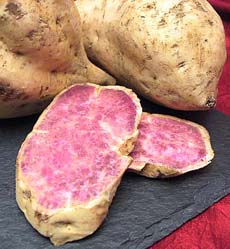| Mushrooms |
Get To Know Me |
Black Trumpet Mushroom
A popular mushroom in French cuisine, the very fresh ones smell of apricots. Its rich, smoky flavor is a wonderful accompaniment to meats or sautéed as a side dish.
Available June-September |
|
Lion’s Mane Mushroom
This variety is named for its cascading mane and treasured for the benefits it offers toward brain function and the nervous system. When cooked, they taste somewhat like lobster, so they are wonderful when cooked with a little butter. |
|
Lobster Mushroom
This is actually not a true mushroom, but rather a parasitic mold that grows on mushrooms, turning them the bright orange/red of a cooked lobster. They have a seafood-like flavor and a dense, meaty texture. They make a great substitute for lobster or as a filler in chowders and bisques.
|
|
Matsutake Mushroom
This is a type of Japanese mushroom with a significant spicy aroma similar to cinnamon. They are meaty like portobellos and add wonderful dimension to a cream of mushroom soup. |
|
| ONION FAMILY |
|
Chinese Leeks
Also known as Chinese Chives, they have a delicate garlic-chive flavor. They can be chopped and prepared in a variety of dishes, but are best tempura-fried or grilled whole.
Available year-round. |
 |
Cippolini Onion
A flat Italian onion with a solid white flesh and sweet, mild flavor. They are traditionally served roasted or baked, but also work well on kebabs.
Available year-round. |
|
Ramps
This plant is also referred to as a wild leek. The entire plant is edible and tastes like a strong combination of onion and garlic. They are extremely popular in the cooking of Quebec and are often fried, but can be adapted to a variety of dishes.
Available March to May. |
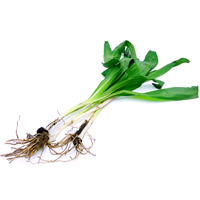 |
Red Baron Scallions
These onions are so pretty that they could qualify as an ornamental plant in a garden. However, they are also pungent and flavorful, and can substitute for green scallions in any meal. |
|
PEPPERS
(For Chile Peppers, see the Chile Pepper Glossary) |
|
Corno di Toro Pepper
A standard heirloom pepper that comes from Italy. As the largest of the sweet stuffing peppers, it's excellent fried, cooked, roasted or stuffed. |
|
Friggitello Pepper
These are also Italian heirloom peppers that are small and tapered. Their skin is mild, making them ideal for a salad. |
|
Golden Baby Belle Pepper
A small bright yellow pepper that is crisp and sweet. They make great bite-size stuffed appetizers. |
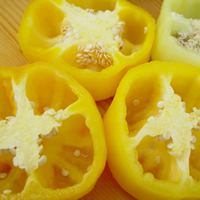 |
Marconi Pepper
An Italian grilling pepper with a tapered green plant that turns red after it matures. It has a sweet, smoky flavor. |
|
Purple Beauty Pepper
These peppers start out purple and will turn red if left to ripen. These are a thick fleshed, sweet pepper, perfect for slicing, stir-frying or adding to salads for color. |
|
| ROOT VEGETABLES |
|
Black Radish
An heirloom vegetable with a rough black root that must be peeled before being eaten, this radish has a distinctive bitter taste. It can be shaved into salads, but is also good boiled and mashed.
Available year-round. |
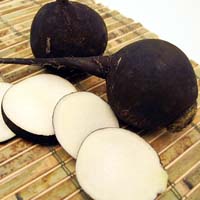 |
Burdock
This is cultivated for its slender roots, and is most popular in Asia. Usually soaked to remove the dirt flavor, they are then a crisp and sweet vegetable that is high in fiber and most often braised. |
|
Celeriac
Celeriac has a large tap root and a celery flavor that is often used in soups or stews. They are edible raw or cooked, but are best eaten peeled. |
|
Daikon
A mild-flavored East Asian white radish. It is most prevalent in Japanese cooking, where it is often pickled and used as a garnish or condiment. In Chinese cuisine, it accompanies the small plates one eats during a meal of Dim Sum.
Available year-round. |
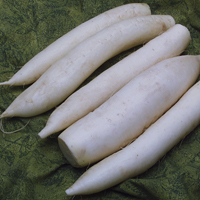 |
Jicama
Jicama is native to Mexico and Central America. The interior is creamy white with a crisp texture that resembles a raw potato or pear. Sweet and Spicy, they add great crunch to a salad, or eaten traditionally with a little lime juice and chile powder.
Available year-round. |
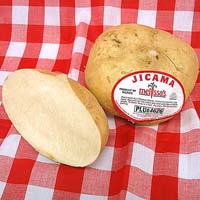 |
Lotus Root
This is the root of the Lotus Water Lily. On the inside are several large air pockets that run the length of the root and give the Lily buoyancy A crisp fibrous texture with a mild distinctive flavor similar to an artichoke makes them great mashed or fried.
Available year-round. |
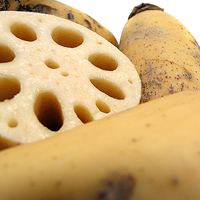 |
Malanga
These vegetables come from some of the oldest root crops in the world and were first cultivated in the Caribbean and Central America. Resembling a yam, the flavor is earthy, and has a similarity to nuts.
Available year-round. |
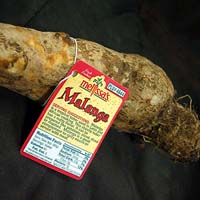 |
Maroon Carrots
This carrot is a deep wine color on the outside with a brilliant orange within. They are rich in flavor and have smooth, edible skins. Sweeter and crunchier than the orange variety, they add color and flavor to salads or soups.
Available year-round. |
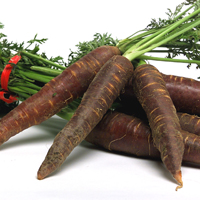 |
Name Root
Shaped like a long sweet potato, the flesh is creamy or yellow in color while its skin can be light brown, dark brown or tan. It is somewhat nutty with a slightly chewy texture similar to a potato. It can be baked, boiled, steamed, scalloped, fried or stewed.
Available year-round. |
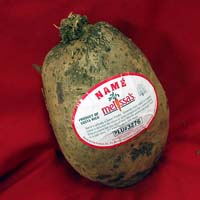 |
Parmex Carrot
Originally from France, these carrots are wonderfully tender with a very smooth skin. They are crunchy, sweet and bite-size, making them most tempting when sautéed in butter. |
|
Parsley Root
This vegetable is most popular in European cooking. They are shaped like carrots and are ivory in color. Their leaves have a slightly more bitter flavor than parsley. They have an earthy taste and rich texture. Great in cassoulets or alongside pork.
Available year-round. |
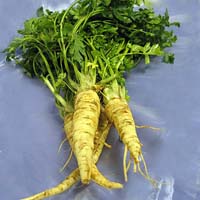 |
Parsnip
A superb sweet and nutty flavor, parsnips are smooth skinned and slender. They can be roasted in olive oil along with other root vegetables and served as a side dish or a main dish over rice.
Available year-round. |
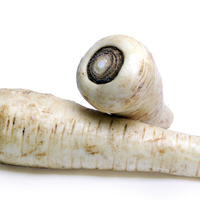 |
Purple Dragon Carrot
What a color contrast with the purple outside and striking orange on the inside. The carrot itself is sweet and a little spicy. They are lovely chopped into salads. |
|
Salsify
Originating in the Mediterranean, it is known for its oyster-like flavor, and is also thought to be similar to the artichoke. It has the texture of an artichoke heart, and the shoots can be used in salads.
Available year-round.
|
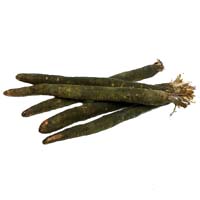 |
White Satin Carrot
This is one of the most mild flavored carrots, with a sweetness to it and a crispy texture. They still share the same nutritional strength of their orange cousins. |
|
SQUASH
(For more exotic squash varieties, see the Squash Glossary) |
|
Bennings Green Tint Squash
A variety of patty pan squash, with a uniform saucer shape and scalloped edges. They have a fine-textured flesh and good flavor. |
|
Flying Saucer Squash
This variety is best when young and tender. Their neat saucer shape and vibrant colors make them a lovely and flavorful dish sautéed, stuffed or stir-fried. |
|
Japanese Cucumber
A few white spines appear on this cucumber’s light green skin, which encloses a crisp white flesh and very low seed content. They can be a substitute for English cucumbers.
Available year-round. |
 |
Mo Qua
A squash of Chinese origin and a relative of winter melon. It looks like a zucchini covered in fuzzy white hairs. Inside, the light-colored, slightly firm flesh is mild and will absorb the flavor of whatever food it is cooked with.
Available year-round. |
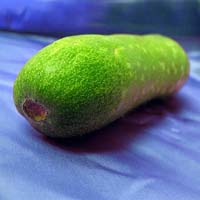 |
Papaya Pear Squash
A bright yellow squash that is tasty raw or cooked. The white flesh is firm and flavorful and the shape makes it ideal for stuffing. |
|
Pul Qua
A squash that originated in southeast Asia. It is long and thin with smooth skin and a yellow-green color. They are a great source of vitamin C and calcium.
Available year-round. |
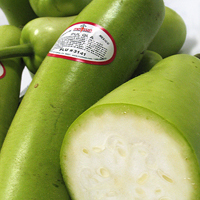 |
Sugar Hubbard Squash
This squash is best cooked diced or cubed, since the rind is bitter and difficult to cut through. |
|
| TUBERS |
|
Boniato
A tropical sweet potato popular in Hispanic communities, it is fluffier, drier and less sweet than a traditional sweet potato. It has a pink to burgundy skin and a white or cream-colored flesh.
Available year-round. |
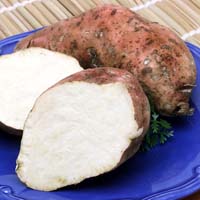 |
Cranberry Red Potato
This potato will hold its rich cranberry-red color through cooking. They have an earthy, buttery flavor and a silky-smooth flesh that makes them great for potato salad.
|
|
Oca
Grown in the Central and Southern Andes, the flavor is slightly tangy and the texture is crunchy until cooked when it can become mealy.
Available June to October. |
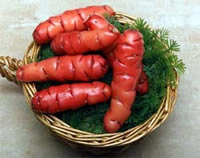 |
Okinawa Sweet Potato
A Hawaiian sweet potato with white skin and lavender flesh. They are best served baked.
Available spring through fall. |
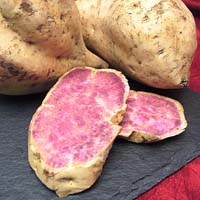 |
Peruvian Purple Potato
From the South American Andes Highlands, it has a purple skin and flesh. They are the mealiest of the fingerling potatoes and so are best served fried. |
|
Cassava Root
This root serves as the third largest source of carbohydrates for human food in the world. The root is long and tapered, and the vegetable is also referred to as Yuca. When raw, Cassava tastes like a mix between potato and coconut, but once it is cooked it takes on a delicate flavor and could replace potatoes in many dishes. |
|
| OTHER EXOTIC VEGETABLES |
|
Chinese Celery
The stalks are thin and hollow and the color can range from white to dark green. They have a strong bitter flavor and are seldom eaten raw.
Available year-round. |
 |
Nopales
A vegetable that comes from the Prickly Pear, and is exposed when peeled to remove the spines. Native to Mexico, they have a light, slightly tart flavor, and a crisp, gluey texture. Popularly served with eggs or in tacos.
Available year-round. |
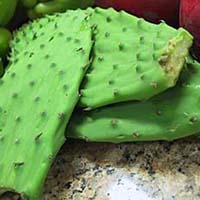 |




